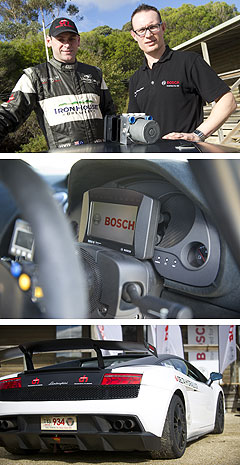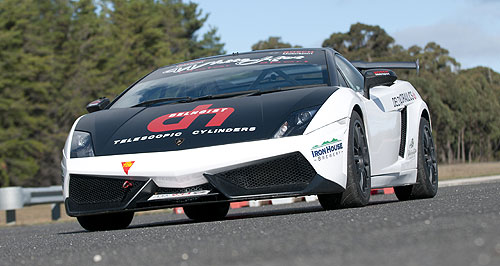Make / Model Search
News - General News - SportBosch enters fast lane in AustraliaWhite Hot: Jason White's Targa Tasmania winning Lamborghini Gallardo Super Trofeo Stradale. New local Bosch motorsport division to offer parts, advice, engineering solutions21 May 2013 By IAN PORTER THE giant Bosch automotive parts group has opened a motorsport division in Australia in a bid to grab a slice of the billion-dollar local motor racing industry and keep its engineers fully employed. And the new Bosch Motorsport division has already claimed its first laurel wreath, thanks to the efforts of Targa Tasmania winners John and Jason White. The new division will offer a full range of services, from selling off-the-shelf systems to advising car builders on the best part to use and helping them tune it when it’s installed so it achieves the optimal result. Furthermore, Bosch will also engineer unique systems to solve particular issues for the serious racer using the accumulated chassis-control brainpower at its Clayton headquarters in Melbourne. That’s what the White Hot Lamborghini Targa Tasmania team did, said Bosch Motorsport product manager Joseph Cavallaro. Bosch Motorsport designed, built and installed a unique brake torque vectoring system for the team’s Targa-winning Gallardo. This sophisticated system, still only available on only a few high-end production cars around the world, improves a car’s handling and traction when entering and leaving corners. “Race teams and enthusiasts have been buying our products from overseas, but they were having difficulty finding someone to talk to about the product or get technical support,” Mr Cavallaro said. “So we decided to take distribution in-house. We want the motorsport division to be the central focal point in Australia for any question, whether it’s a technical enquiry, part selection, pricing, quotations, orders, shipment, deliveries, the works.” Mr Cavallaro said the initial parts catalogue would comprise 200 high-volume parts, although Bosch Motorsport will be able to source all 5000-plus motorsport components available throughout the Bosch world. These cover nine major categories: engine control units (petrol and diesel), injection, ignition, alternators and starter motors, sensors, brake control units, digital displays, data logging systems, software and various accessories. But it’s the engineering capability that sets Bosch Motorsports apart from other race tuners and parts suppliers, Mr Cavallaro said. “There is one fundamental aspect to what we are trying to do as a motorsport team,” he said. “It’s not only the products, not only the service of the existing products, but – and this is where we differentiate ourselves from our competitors – we offer custom engineering solutions.” Mr Cavallaro said Bosch Australia has 150 engineers on site at Clayton in various teams, all working in automotive, with many of them are passionate about motorsport.  “So we have the ability to draw on existing automotive experience to design and develop a custom solution for a race team or a race car owner,” he said. “For example, if they want something that is not already in our catalogue, or isn’t available in anyone’s catalogue, we can provide it. “If they can give us a set of requirements, what they want to achieve, we can go away and figure out the hardware and the software, develop it, test it, implement it in their vehicle and deliver it to them.” Building a complex braking system from scratch, with all the functions like ABS, traction control, stability control and torque vectoring is an elaborate job and might cost $40,000 or $50,000. But Mr Cavallaro said Bosch Motorsport would also be able to offer solutions to the more typical sort of frustration car builders find when one component won’t combine properly with another. “Electrical architectures are becoming much more complicated in motor vehicles these days – everything’s running on CAN bus (controller area network bus) these days – and the average mechanic or motorsport engineer, whilst being very competent in certain areas, can’t be competent in every area,” Mr Cavallaro said. A CAN bus enables every microcontroller and device on a vehicle to communicate with each other without a host computer. “One customer came to us for an electrical solution, so we came up with a customised piece of hardware and software that translated various signals from one electric module into the right format for another module to use,” Mr Cavallaro said. “That cost him less than $1500.” Bosch Australia’s work with the local car-makers gives Bosch Motorsport the opportunity to offer these up-to-the-minute skills to the race industry. The company developed the ABS system on the new HSV Gen-F GTS model, which has torque vectoring. Brake torque vectoring helps when a car is braking into a corner. The system applies the brake on the inside rear wheel, pulling the nose more quickly into the corner and reducing understeer. When the car is leaving the corner, the system also applies the inside rear brake of a rear-wheel-drive or all-wheel-drive car. This limits wheelspin on the inside rear wheel, transferring more torque to the outside wheel and improving acceleration. “From the OE experience with torque vectoring at a production car level, we are able to take our understanding of torque vectoring and then customise it, cut it back and use it at the motorsport level,” Mr Cavallaro said. He added that in racing categories that allowed it, ABS brakes would offer improved lap times and, more than likely, reduced running costs. “The best driver in the world could probably outbrake an ABS system once, but even the best driver in the world is not going to be able to match an ABS system on every stop, on every turn, on every type of surface, whether it’s raining, gravel, damp, whatever,” he said. “The ABS system does give you the maximum potential every stop.” What’s more, it prevents a driver from damaging his tyres with a lock-up, which can leave tyres with flat spots. “The good thing about the ABS system is you will no longer flat-spot your tyres. If you are in a racing category that is cost-sensitive -- tyres can cost $1000 each. ABS is a great way of saving tyres and lowering costs. “If you’ve got ABS it means you are less likely to lock up your wheels and potentially skid off the track and hit something and you will do less damage to your vehicle, so you’re saving repair bills as well.”  Read more22nd of November 2012  Parts-makers pick up $6.5m in fundingLocal suppliers win first-round funding under auto diversification, expansion scheme3rd of August 2012  Bosch backs incentives for safer carsLowering average vehicle age key to tackling road toll, says Bosch Australia20th of July 2012  Autonomous cars soonBosch says virtually self-driving cars are now feasible and will soon be with us9th of December 2011  Bosch looks offshore to remain viable in AustraliaCar parts giant Bosch drawn to EVs as local industry woes put it in holding pattern25th of March 2011  Bosch cuts Australian manufacturing380 jobs to go as Bosch Australia shifts manufacturing operations to Asia and Europe |
Click to shareGeneral News articlesResearch General News Motor industry news |











Facebook Twitter Instagram